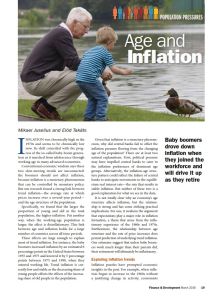Acesse a sua conta getAbstract para obter o resumo!

Acesse a sua conta getAbstract para obter o resumo!
Mikael Juselius and Elöd Takáts
Age and Inflation
Finance & Development
Finance & Development Magazine, 2016
Sobre o que é?
Though subdued for now, inflation could make a comeback as the population ages.
Recommendation
Economists have a number of theories about why inflation flares up during certain periods and dies down in others. While age trends within a population are seldom-explored causes of inflation, new evidence suggests that they may be important drivers. Economists Mikael Juselius and Elöd Takáts find that a large working-age population correlates with disinflationary periods, while inflationary times occur when the young and old dominate. So as many of the world’s major economies age, inflation may make a comeback. getAbstract recommends this important article to economists and others interested in how age-related trends might affect future prices.
Summary
About the Authors
Mikael Juselius is a senior economist at the Bank of Finland. Elöd Takáts is a senior economist at the Bank for International Settlements.


















Comment on this summary